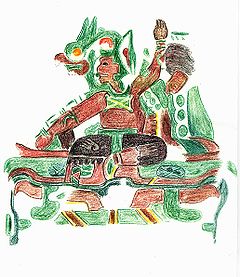Oxtotitlán
| Cueva de Oxtotitlán | |

enthroned ruler wearing what has been identified as an owl costume (Mural 1 artist rendition)
|
|
| Location | Chilapa de Álvarez, Guerrero |
|---|---|
| Region | [[]] |
| Coordinates | 17°47′N 98°57′W / 17.783°N 98.950°WCoordinates: 17°47′N 98°57′W / 17.783°N 98.950°W |
| Type | rock shelter |
| History | |
| Periods | Mesoamerican Preclassical, Approx. 900 years BCE |
| Cultures | Olmec |
Oxtotitlán is the name of a natural rock shelter and archaeological site in Chilapa de Álvarez, Mexican state of Guerrero that contains murals linked to the Olmec motifs and iconography. Along with the nearby Juxtlahuaca cave, the Oxtotitlán rock paintings represent the "earliest sophisticated painted art known in Mesoamerica", thus far. Unlike Juxtlahuaca, however, the Oxtotitlán paintings are not deep in a cave system but rather occupy two shallow grottos on a cliff face.
The paintings have been variously dated to perhaps 900 years BCE or 800 to 500 years BCE. It is not known what group or society painted them. It is also not known how Olmec-influenced art came to be painted hundreds of kilometers (or miles) from the Olmec heartland, although caves are prominent on many Olmec-style monuments, including La Venta Altars 4 and 5.
The Paintings cover an area of about 200 m2 (2,200 sq ft) There is restoration work in 10 walls, it is expected to complete scientific investigation and establish the origin of the paints used in the designs.
The best-known samples of Oxtotitlán paintings are those part of the core group. These are two Polychrome murals, one of which represent a sitting character on a mythological Olmec serpent, wearing a mask, according to Grove, could be a representation of an Owl. The other mural of the central group has been severely damaged by time and the environment, making it difficult to identify. Internal murals are monochrome (black and white), or bi-chromos, combining elements of red and black.
Unlike Juxtlahuaca, it is possible that Oxtotitlán contained a housing area, because ceramic materials have been found in the vicinity of the Quiotepec Hill.
The paintings are distributed in three areas with a separate type of painting assigned to each area.
...
Wikipedia

